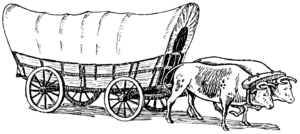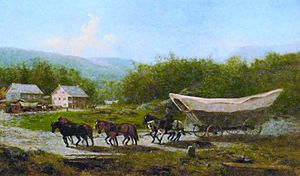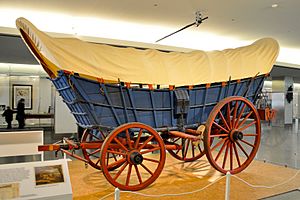Conestoga wagon facts for kids
The Conestoga wagon was a special kind of large, heavy covered wagon. People used it a lot in the late 1700s and 1800s. It was popular in the eastern United States and Canada. This wagon could carry very heavy loads, sometimes up to 6 tons! Horses, mules, or oxen pulled these big wagons.
The Conestoga wagon was built to keep its contents safe. It stopped things from moving around inside. It also helped the wagon cross rivers and streams. Sometimes, though, it needed to be sealed with caulking to stop leaks. Most covered wagons used for moving west in the U.S. were not true Conestoga wagons. They were usually regular farm wagons with canvas covers. True Conestoga wagons were often too heavy for the flat prairies.
History of the Conestoga Wagon
The first time the name "Conestoga wagon" was written down was on December 31, 1717. A man named James Logan bought one from James Hendricks. The wagon got its name from the Conestoga River or Conestoga Township. Both are in Lancaster County, Pennsylvania. Many people think German settlers first used these wagons. They used them to carry goods to Philadelphia.
During colonial times, the Conestoga wagon was very popular. People used it to travel south through the Great Appalachian Valley. They followed a path called the Great Wagon Road. After the American Revolution, these wagons helped open up trade. They carried goods to cities like Pittsburgh and the Ohio area. Around 1820, it cost about one dollar to move 100 pounds of goods 100 miles. The wagons could travel about 15 miles (24 km) each day.
The Conestoga wagon was the main way to move cargo over the Appalachian Mountains. This was true until railroads were built. A team of up to eight horses or twelve oxen usually pulled the wagon. In Canada, Pennsylvania German families used Conestoga wagons. They moved from the United States to Southern Ontario. They settled in places like Niagara Region and the Kitchener-Waterloo area. They also settled in York Region, especially in Markham and Stouffville.
How Conestoga Wagons Were Built
The Conestoga wagon had a special design. Its floor was curved upward. This helped stop the cargo from tipping or sliding around. An average Conestoga wagon was about 18 feet (5.4 meters) long. It was 11 feet (3.3 meters) high and 4 feet (1.2 meters) wide. It could carry up to 12,000 pounds (5,443 kg) of cargo.
The wagon's body had seams that were sealed with tar. This kept water out when crossing rivers. A strong white canvas cover stretched over the wagon. This protected the cargo from bad weather. The wagon's frame and parts that held it up were made of wood. The wheels often had iron rims to make them stronger. Water barrels were attached to the side of the wagon. Toolboxes held tools for repairs. A feed box at the back was used to feed the horses.
Early freight wagons were not made for people to ride inside. The wagon had a brake handle on its left side. The driver, called a teamster, usually walked beside the wagon. Sometimes, they could stand or sit on a pull-out board. This board was called a lazy board. It gave the teamster access to the brake handle. The horse closest to the wagon on the left side was called the wheel horse. Sometimes, the teamster would ride this horse. The Conestoga wagon helped start the custom of "driving" on the right side of the road.
Conestoga Draft Horse
To pull these very heavy wagons, a special kind of horse was needed. These were called Conestoga horses. They were strong, medium to heavy draft horses. The Conestoga horse was not a specific breed with a strict family tree. They could be different colors. These horses were developed in the same area as the wagon, Lancaster County. They were bred out of necessity, not by scientific methods.
A prominent landowner named Samuel Gist helped with the breeding of these horses. In 1732, Gist brought a special horse named Bulle Rock from England. Breeding this horse with local mares led to larger horses. These larger mares were then bred with horses that may have come from Flemish ancestry.
Over time, as railroads became more common, the need for Conestoga wagons and their horses decreased. By 1864, people predicted the end of the Conestoga horse.





